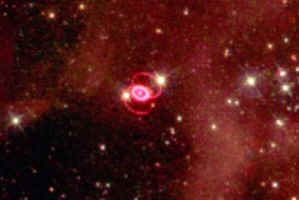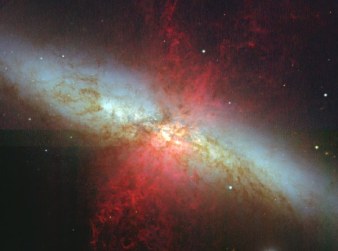|
{Please
scroll
down. There is more below.}
Superclusters
While galaxies are a mere hundred thousand
light-years across and clusters not more than
ten million or so, a supercluster might snake
through a few hundred million light-years of
space.
It turns out that galaxies almost never move
much faster than a thousand kilometers per
second, about one-three-hundredths as fast as
the speed of light. Simply put, if these objects
exist, the universe cannot have begun twenty
billion years ago.
In 1990 the existence of these huge objects was
confirmed by several teams of astronomers. The
most dramatic work was that of Margaret J.
Geller and John P. Huchra of the Harvard
Smithsonian Center for Astrophysics, who are
mapping galaxies within about six hundred
million light-years of earth. In November of
1989 they announced their latest results,
revealing what they called the "Great Wall,
a huge sheet a galaxies stretching in every
direction off the region mapped. The sheet, more
than two hundred million light-years across and
seven hundred million light-years long, but only
about twenty million light-years thick,
coincides with a part of one of the supercluster
complexes mapped by Tully. The difference is
that the new results involve over five thousand
individual galaxies, and thus are almost
impossible to question as statistical flukes.
| There
are many other discoveries on large
structures like these which the
discoverers themselves think can
contradict the theory of Big bang.
Cosmologists today say the blast from the
Big bang was extremely smooth and uniform,
according to the background radiation it
allegedly left behind. How could such a
smooth start have led to such massive and
complex structures? How so much structure
could have formed within the
15-billion-year age of the Universe? |
 |
| Notes:
We, the members of kosmandu, are waiting
for M. Saleem form Pakistan to come to
Kathmandu to give us lectures on
Cosmology. This man himself had published
his theory of Contradiction of Big Bang in
1990-91. He wrote in his book 'Mysteries
of Mysterious Universe' that these
galaxies, we have observed to be receding
from us, are in fact moving due to gravity
of a Super cluster (indeed very much super
size cluster) very far away from the
observed part of the Universe (or inside)
and of course not due to 'Big Bang 14
billion years back'. |
 |
| Halton
Arp and his discovery
Prof.
Halton Arp, Max Planck Institute For
Astrophysics, Germany.
HE has an
experience of more than 50 years. He had
his first post doctoral position as an
assistant to Edwin Hubble when, during
1953-55 he searched for Supernova confirm
the Hubble's law of red shift of galaxies.
He has
found what seems to be a nearby galaxy
with a jet of matter is pointing towards a
distant quasar (Quasars have large red
shifts and are thought to be the farthest
objects in the Universe). It is as
if the quasar is having a gravitational
effect on the nearby galaxy. but in order
for that to be the case, the pair must be
very close together. So Arp believes, this
example proves both the Big Bang theory
and Hubble-wrong!
|

The
pictures have no relation to the
observations described in this page.
|
| Today's
biggest question certainly is: What
is supposed to have caused the big bang
itself (if it ever happened)?
So
for more you have to wait or subscribe
to our newsletters to get updated on the
theories of the cosmos.
|
|